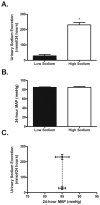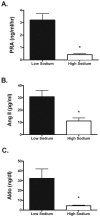High dietary sodium intake impairs endothelium-dependent dilation in healthy salt-resistant humans
- PMID: 23263240
- PMCID: PMC4176919
- DOI: 10.1097/HJH.0b013e32835c6ca8
High dietary sodium intake impairs endothelium-dependent dilation in healthy salt-resistant humans
Abstract
Background: Excess dietary sodium has been linked to the development of hypertension and other cardiovascular diseases. In humans, the effects of sodium consumption on endothelial function have not been separated from the effects on blood pressure. The present study was designed to determine if dietary sodium intake affected endothelium-dependent dilation (EDD) independently of changes in blood pressure.
Method: Fourteen healthy salt-resistant adults were studied (9M, 5F; age 33 ± 2.4 years) in a controlled feeding study. After a baseline run-in diet, participants were randomized to a 7-day high-sodium (300-350 mmol/day) and 7-day low-sodium (20 mmol/day) diet. Salt resistance, defined as a 5 mmHg or less change in a 24-h mean arterial pressure, was individually assessed while on the low-sodium and high-sodium diets and confirmed in the participants undergoing study (low-sodium: 85 ± 1 mmHg; high-sodium: 85 ± 2 mmHg). EDD was determined in each participant via brachial artery flow-mediated dilation on the last day of each diet.
Results: Sodium excretion increased during the high-sodium diet (P < 0.01). EDD was reduced on the high-sodium diet (low: 10.3 ± 0.9%, high: 7.3 ± 0.7%; P < 0.05). The high-sodium diet significantly suppressed plasma renin activity (PRA), plasma angiotensin II, and aldosterone (P < 0.05).
Conclusion: These data demonstrate that excess salt intake in humans impairs endothelium-dependent dilation independently of changes in blood pressure.
Figures



Comment in
-
Vascular effects of high-salt intake.J Hypertens. 2013 Mar;31(3):472-3. doi: 10.1097/HJH.0b013e32835e8de1. J Hypertens. 2013. PMID: 23615208 No abstract available.
Similar articles
-
High dietary sodium reduces brachial artery flow-mediated dilation in humans with salt-sensitive and salt-resistant blood pressure.J Appl Physiol (1985). 2015 Jun 15;118(12):1510-5. doi: 10.1152/japplphysiol.00023.2015. Epub 2015 Apr 2. J Appl Physiol (1985). 2015. PMID: 26078434 Free PMC article.
-
Seven-Day Salt Loading Impairs Microvascular Endothelium-Dependent Vasodilation without Changes in Blood Pressure, Body Composition and Fluid Status in Healthy Young Humans.Kidney Blood Press Res. 2019;44(4):835-847. doi: 10.1159/000501747. Epub 2019 Aug 20. Kidney Blood Press Res. 2019. PMID: 31430746
-
High dietary sodium augments vascular tone and attenuates low-flow mediated constriction in salt-resistant adults.Eur J Appl Physiol. 2020 Jun;120(6):1383-1389. doi: 10.1007/s00421-020-04370-0. Epub 2020 Apr 18. Eur J Appl Physiol. 2020. PMID: 32306153 Free PMC article. Clinical Trial.
-
Impaired endothelium-dependent flow-mediated vasodilation in hypertensive subjects with hyperaldosteronism.Circulation. 2004 Jun 15;109(23):2857-61. doi: 10.1161/01.CIR.0000129307.26791.8E. Epub 2004 Jun 1. Circulation. 2004. PMID: 15173035
-
Impact of Salt Intake on the Pathogenesis and Treatment of Hypertension.Adv Exp Med Biol. 2017;956:61-84. doi: 10.1007/5584_2016_147. Adv Exp Med Biol. 2017. PMID: 27757935 Review.
Cited by
-
Salt, Not Always a Cardiovascular Enemy? A Mini-Review and Modern Perspective.Medicina (Kaunas). 2022 Aug 29;58(9):1175. doi: 10.3390/medicina58091175. Medicina (Kaunas). 2022. PMID: 36143852 Free PMC article. Review.
-
High salt intake as a multifaceted cardiovascular disease: new support from cellular and molecular evidence.Heart Fail Rev. 2015 Jul;20(4):461-74. doi: 10.1007/s10741-015-9478-7. Heart Fail Rev. 2015. PMID: 25725616 Review.
-
Dairy Foods and Dairy Fats: New Perspectives on Pathways Implicated in Cardiometabolic Health.Adv Nutr. 2020 Mar 1;11(2):266-279. doi: 10.1093/advances/nmz105. Adv Nutr. 2020. PMID: 31555799 Free PMC article. Review.
-
Phyllanthus amarus attenuated derangement in renal-cardiac function, redox status, lipid profile and reduced TNF-α, interleukins-2, 6 and 8 in high salt diet fed rats.Heliyon. 2021 Oct 1;7(10):e08106. doi: 10.1016/j.heliyon.2021.e08106. eCollection 2021 Oct. Heliyon. 2021. PMID: 34660924 Free PMC article.
-
The Role of Nitric Oxide in the Micro- and Macrovascular Response to a 7-Day High-Salt Diet in Healthy Individuals.Int J Mol Sci. 2023 Apr 12;24(8):7157. doi: 10.3390/ijms24087157. Int J Mol Sci. 2023. PMID: 37108318 Free PMC article.
References
-
- Luscher TF, Tanner FC, Tschudi MR, Noll G. Endothelial dysfunction in coronary artery disease. Annu Rev Med. 1993;44:395–418. - PubMed
-
- Lloyd-Jones D, Adams RJ, Brown TM, Carnethon M, Dai S, De Simone G, et al. Heart disease and stroke statistics--2010 update: a report from the American Heart Association. Circulation. 2010;121:e46–e215. - PubMed
-
- Tuomilehto J, Jousilahti P, Rastenyte D, Moltchanov V, Tanskanen A, Pietinen P, et al. Urinary sodium excretion and cardiovascular mortality in Finland: a prospective study. Lancet. 2001;357:848–51. - PubMed
-
- Frassetto L, Morris RCJ, Sellmeyer DE, Todd K, Sebastian A. Diet, evolution and aging--the pathophysiologic effects of the post-agricultural inversion of the potassium-to-sodium and base-to-chloride ratios in the human diet. Eur J Nutr. 2001;40:200–13. - PubMed
Publication types
MeSH terms
Substances
Grants and funding
LinkOut - more resources
Full Text Sources
Other Literature Sources
Research Materials

